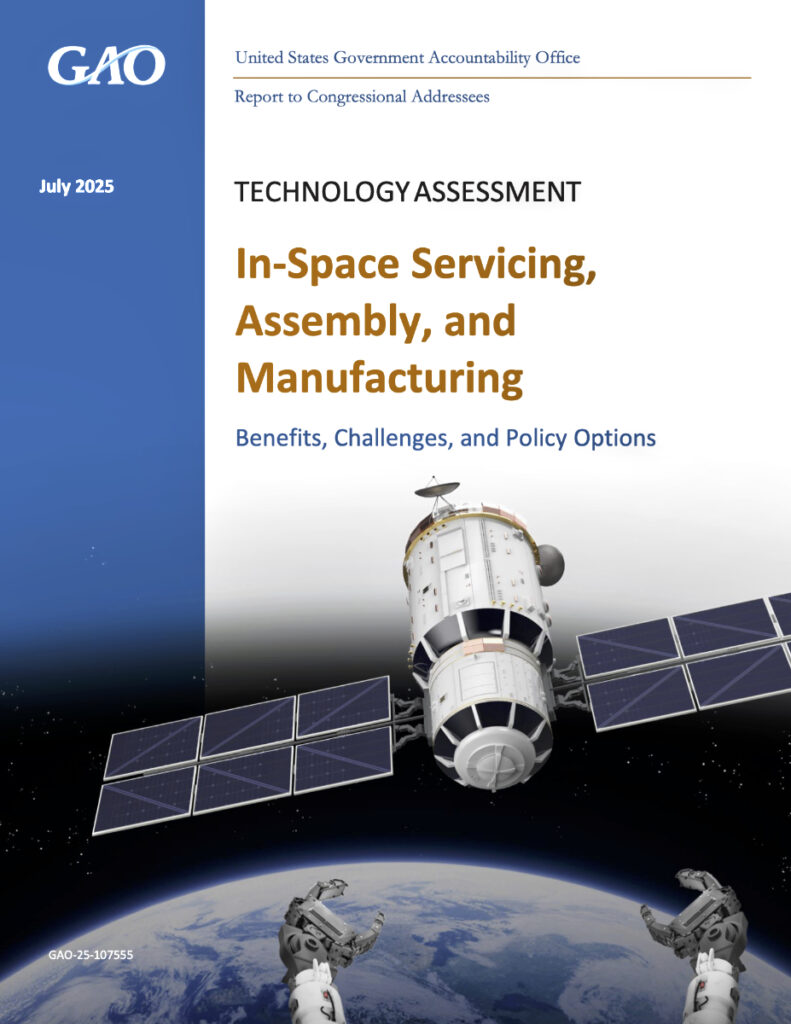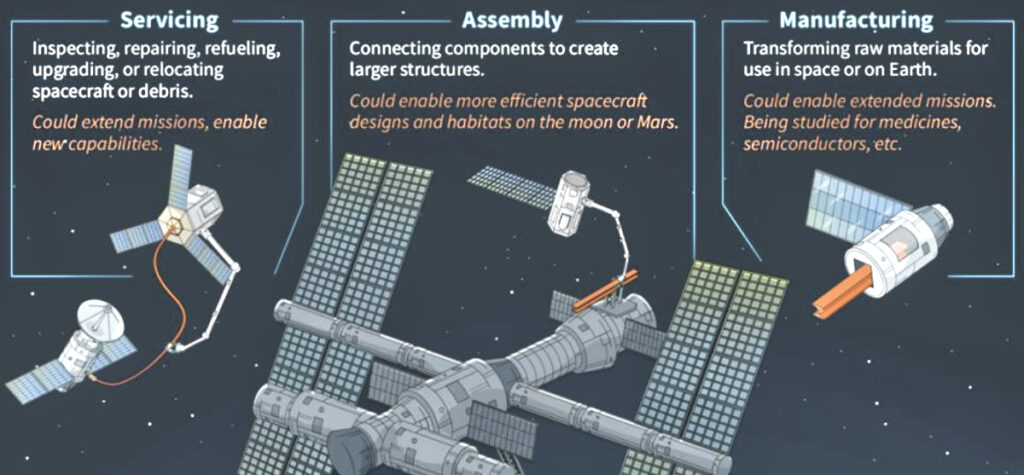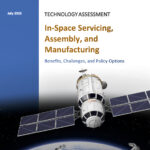
Satellites are used for GPS, weather forecasts, and more. Generally, satellites have to be small and tough enough to withstand launch. Repairing or upgrading them involves sending people to space—so they usually aren’t made to be serviced. In-space robotic servicing could change this and open the door to other advances, like in-space assembly and manufacturing. However, the technology is mostly unproven in space. Companies and U.S. agencies are hesitant to commit resources to it.
We offered policy options to address this and other challenges. For example, requiring satellites to be serviceable could create a user base for in-space service companies.
Space is increasingly important to the daily lives of Americans, to the economy, and to national defense. The number of active satellites in space providing critical services increased from 1,400 in 2015 to more than 11,000 in 2025. An additional 18,000 or more are projected to be launched by 2030, according to market analyses.
In-space servicing, assembly, and manufacturing (ISAM) technology has the potential to improve current satellite capabilities and to open new capabilities, such as orbital debris removal, space-based solar energy, larger space telescopes, and human deep-space space exploration.

In 2022, the Office of Science and Technology Policy published a national strategy and an implementation plan to guide federal ISAM activities. The plan named various agencies, including the Department of Defense (DOD) and the National Aeronautics and Space Administration (NASA), to lead these activities. DOD and NASA have spent more than $2 billion developing in-space servicing demonstration missions over the past decade, according to agency documentation and officials. Other countries are also developing and demonstrating ISAM technologies.
Definitions of in-space servicing, assembly, and manufacturing

While astronauts have repaired the Hubble Space Telescope and assembled and maintained the International Space Station, robotic ISAM functions are less mature. Robotic in-space servicing is not routinely used and has only been demonstrated on a handful of missions, but it is more mature than assembly and manufacturing.
Development of ISAM technology faces challenges largely related to what experts called a chicken-and-egg problem. Potential ISAM service providers are hesitant to develop the technology into servicing products (e.g., a satellite that can bring fuel to other satellites) until there is a user base (e.g., a refuelable satellite). Similarly, potential users are hesitant to design and deploy satellites that can be serviced until those products are available.
GAO identified four challenges contributing to this situation:
- Government agencies and industry have differing priorities for ISAM technology, and a single technology is unlikely to meet all priorities. This situation fragments demand for any given technology.
- Government and private satellite operators are generally not requiring that satellites be designed for future servicing, such as refueling or upgrading.
- Few in-space test opportunities are available for developers to test ISAM technology. As a result, ISAM providers have generally not demonstrated the capability to perform satellite servicing, which deters risk-averse satellite operators from committing to purchasing such servicing.
- Regulations and standards are unclear or emerging, both for space activities broadly and ISAM specifically.
GAO developed five policy options that could help address these challenges. These policy options are not recommendations. GAO presents them to help policymakers consider and choose options appropriate to the goals they hope to achieve. Policymakers may include legislative bodies, government agencies, standards-setting organizations, and industry.
Policy options to help address challenges with in-space servicing, assembly, and manufacturing (ISAM) technology development and use
Policy Option Opportunities Considerations
Maintain status quo efforts (report p. 24)
For example, federal agencies, ISAM providers, and other policymakers could sustain current planned demonstration missions and ISAM community efforts.
- Current efforts may address some challenges without additional resources.
- Resources that would have been allocated to further developing ISAM could be used for other opportunities.
- Current efforts are not likely to address all challenges, such as not being able to promptly respond to changing mission needs or satellite failures.
Evaluate, and potentially promote serviceability (report p. 25)
For example, federal agencies could study the economic benefits and costs of serviceability and then take actions, such as requiring that satellites be serviceable to enable repair, maintenance, or future technology upgrades.
- Evaluations of benefits could clarify whether and when serviceability can generate return on investment, which would help inform decisions about which other policy options to pursue.
- Requirements could establish a user base and incentivize servicing providers.
- Could be relatively inexpensive compared to the overall cost of a satellite.
- Historical data may not be sufficient to generate reliable evaluations.Some benefits of satellite servicing may not be easily quantifiable.
Support technology development and testing (report p. 27)
For example, the ISAM community could take steps to support testing opportunities on the ground and in space.
- More testing could enable smaller companies and academic research groups to participate in developing ISAM capabilities.
Could reduce technical risk, satisfy many potential users, and encourage adoption.
Resources dedicated to test facilities and demonstrations would not be available for other agency or company priorities.
Demonstrations would not guarantee adoption by users.
Develop or clarify regulations and standards (report p. 28)
For example, government agencies and standards organizations could clarify licensing or promulgate standards.
- Could lower barriers for ISAM providers.
- Government and industry may not be prepared to specify regulations or standards.
- The ISAM industry is still developing, and regulations may inadvertently create unnecessary barriers to developing technology.
Designate a government champion (report p. 29)
For example, Congress or the White House could designate a government champion to support ISAM development and coordinate with the Consortium for Space Mobility and ISAM Capabilities.

- The government champion could oversee and coordinate activities described in the ISAM National Strategy and the National ISAM Implementation Plan, and the policy options identified in this report.
- A government champion without sufficient authority, resources, and clear direction could be ineffective.
Why GAO Did This Study
ISAM technology and capabilities could change the paradigm of how spacecraft are designed, built, operated, and discarded. Since the advent of artificial satellites, almost all have been “single use”: assembled on Earth, sustained in space with no outside intervention beyond communication, and discarded or abandoned when no longer functional. ISAM could reduce cost and risk, increase flexibility, and help to better address failures after launch.
NASA and others have used ISAM capabilities for more than 40 years, but largely involving crewed missions rather than uncrewed robotic missions. For example, astronauts repaired or upgraded the Hubble Space Telescope five times between 1993 and 2009.
This report describes potential benefits and status of ISAM capabilities as well as challenges facing their development and use. It also identifies options policymakers could consider that might help realize benefits and address challenges.
To conduct this technology assessment, GAO searched the relevant literature; reviewed documents and reports; interviewed federal officials, industry representatives, and stakeholders in academia and at federally funded research and development centers; conducted site visits; attended conferences and workshops; and convened a 2-day meeting of 20 experts from government, industry, academia, and federally funded research and development centers. GAO excluded sensitive and classified information. GAO is identifying policy options in this report.

